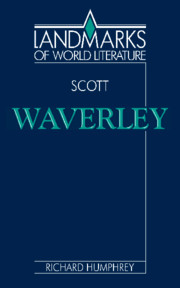3 - Waverley as history
Published online by Cambridge University Press: 27 January 2010
Summary
Historical fiction and history as temporal structures
were we to point out the most marked distinction between a real and a fictitious narrative …
Introduction to The Abbot‘Historical fiction is not history, but it springs from history and reacts upon it’ (88): Trevelyan's words of 1921 are still an appropriate beginning. They remind one that historical fiction, notably in the case of Scott, has had a marked influence on historiography – so much so that one cannot do full justice to Waverley without placing it in its relationship both to history in general and to the developing history of the Forty-five. But this first entails investigating what historiography and historical fiction, for all their differences, have in common.
There is the past (res gestae) and there is history (historia rerum gestarum). As the Greek philosopher Agathon said, not even God can change the past – although many might like to. History, however, is not the past but an account of the past and is forever being re-written, the type or types of historical account written being also subject to development and change. History, as the great Dutch historian Pieter Geyl claimed, is ‘a debate without end’, so that what one reads is never ‘the history of …’, but always ‘a history of …’.
The essential similarity between histories and historical fictions is that both are (usually) narratives.
- Type
- Chapter
- Information
- Scott: Waverley , pp. 74 - 94Publisher: Cambridge University PressPrint publication year: 1993



